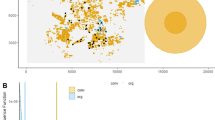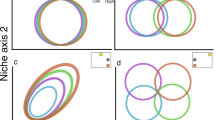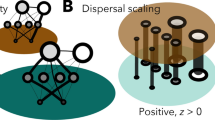Abstract
Dispersal of organisms generates gene flow between populations. Identifying factors that influence dispersal will help predict how species will cope with rapid environmental change. We developed an innovative infrastructure, the Metatron, composed of 48 interconnected patches, designed for the study of terrestrial organism movement as a model for dispersal. Corridors between patches can be flexibly open or closed. Temperature, humidity and illuminance can be independently controlled within each patch. The modularity and adaptability of the Metatron provide the opportunity for robust experimental design for the study of 'meta-systems'. We describe a pilot experiment on populations of the butterfly Pieris brassicae and the lizard Zootoca vivipara in the Metatron. Both species survived and showed both disperser and resident phenotypes. The Metatron offers the opportunity to test theoretical models in spatial ecology.
This is a preview of subscription content, access via your institution
Access options
Subscribe to this journal
Receive 12 print issues and online access
$259.00 per year
only $21.58 per issue
Buy this article
- Purchase on Springer Link
- Instant access to full article PDF
Prices may be subject to local taxes which are calculated during checkout





Similar content being viewed by others
References
Tilman, D. & Kareiva, P. Spatial Ecology (Princeton Univ. Press, 1997).
Ronce, O. How does it feel to be like a rolling stone? Ten questions about dispersal evolution. Annu. Rev. Ecol. Evol. Syst. 38, 231–253 (2007).
Kokko, H. & López-Sepulcre, A. From individual dispersal to species ranges: Perspectives for a changing world. Science 313, 789–791 (2006).
Clobert, J., De Fraipont, M. & Danchin, E. Evolution of dispersal. in Behavioural Ecology (eds. Danchin, E., Angibault, J.M. & Cezilly, F.) Ch. 9, 323–359 (Oxford Univ. Press, 2008).
Clobert, J., Le Galliard, J.F., Cote, J., Meylan, S. & Massot, M. Informed dispersal, heterogeneity in animal dispersal syndromes and the dynamics of spatially structured populations. Ecol. Lett. 12, 197–209 (2009).
Montoya, J.M. & Raffaelli, D. Climate change, biotic interactions and ecosystem services. Phil. Trans. R. Soc. Lond. B 365, 2013–2018 (2010).
Gonzalez, A., Lawton, J.H., Gilbert, F.S., Blackburn, T.M. & Evans-Freke, I. Metapopulation dynamics, abundance, and distribution in a microecosystem. Science 281, 2045–2047 (1998).
Collinge, S.K. Effects of grassland fragmentation on insect species loss, colonization, and movement patterns. Ecology 81, 2211–2226 (2000).
Tewksbury, J.J. et al. Corridors affect plants, animals, and their interactions in fragmented landscapes. Proc. Natl. Acad. Sci. USA 99, 12923–12926 (2002).
Levey, D.J., Bolker, B.M., Tewksbury, J.J., Sargent, S. & Haddad, N.M. Effects of landscape corridors on seed dispersal by birds. Science 309, 146–148 (2005).
Damschen, E.I., Haddad, N.M., Orrock, J.L., Tewksbury, J.J. & Levey, D.J. Corridors increase plant species richness at large scales. Science 313, 1284–1286 (2006).
Ferraz, G. et al. A large-scale deforestation experiment: effects of patch area and isolation on Amazon birds. Science 315, 238–241 (2007).
Cadotte, M.W. & Fukami, T. Dispersal, spatial scale, and species diversity in a hierarchically structured experimental landscape. Ecol. Lett. 8, 548–557 (2005).
Bowler, D.E. & Benton, T.G. Causes and consequences of animal dispersal strategies: relating individual behaviour to spatial dynamics. Biol. Rev. Camb. Philos. Soc. 80, 205–225 (2005).
Bowler, D.E. & Benton, T.G. Variation in dispersal mortality and dispersal propensity among individuals: the effect of age, sex and resource availability. J. Anim. Ecol. 78, 1234–1241 (2009).
Lecomte, J. & Clobert, J. Dispersal and connectivity in populations of the common lizard Lacerta vivipara: an experimental approach. Acta Oecologica 17, 585–598 (1996).
Le Galliard, J.-F., Ferrière, R. & Clobert, J. Mother-offspring interactions affect natal dispersal in a lizard. Proc. R. Soc. Lond. B Viol. Sci. 270, 1163–1169 (2003).
Cote, J., Clobert, J. & Fitze, P.S. Mother-offspring competition promotes colonization success. Proc. Natl. Acad. Sci. USA 104, 9703–9708 (2007).
Ims, R.A. & Andreassen, H.P. Spatial synchronization of vole population dynamics by predatory birds. Nature 408, 194–196 (2000).
Hanski, I.A. & Gaggiotti, O.E. Ecology, Genetics and Evolution of Metapopulations (Academic, 2004).
Holyoak, M., Leibold, M.A. & Holt, R.D. Metacommunities: Spatial Dynamics and Ecological Communities (Univ. Chicago Press, 2005).
Loreau, M., Mouquet, N. & Holt, R.D. Meta-ecosystems: a theoretical framework for a spatial ecosystem ecology. Ecol. Lett. 6, 673–679 (2003).
Massot, M., Clobert, J., Pilorge, T., Lecomte, J. & Barbault, R. Density dependence in the common lizard: demographic consequences of a density manipulation. Ecology 73, 1742–1756 (1992).
Mueller, T. & Fagan, W.F. Search and navigation in dynamic environments - from individual behaviors to population distributions. Oikos 117, 654–664 (2008).
Schtickzelle, N. & Baguette, M. Behavioural responses to habitat patch boundaries restrict dispersal and generate emigration–patch area relationships in fragmented landscapes. J. Anim. Ecol. 72, 533–545 (2003).
Schtickzelle, N., Joiris, A., Van Dyck, H. & Baguette, M. Quantitative analysis of changes in movement behaviour within and outside habitat in a specialist butterfly. BMC Evol. Biol. 7, 4 (2007).
Hanski, I. Metapopulation dynamics. Nature 396, 41–49 (1998).
De Meester, L. et al. Ponds and pools as model systems in conservation biology, ecology and evolutionary biology. Aquat. Conserv.: Mar. Freshw. Ecosyst. 15, 715–725 (2005).
Massot, M. & Clobert, J. Processes at the origin of similarities in dispersal behaviour among siblings. J. Evol. Biol. 13, 707–719 (2000).
Baguette, M., Clobert, J. & Schtickzelle, N. Metapopulation dynamics of the bog fritillary butterfly: experimental changes in habitat quality induced negative density-dependent dispersal. Ecography 34, 170–176 (2011).
White, G.C. & Burnham, K.P. Program MARK: survival estimation from populations of marked animals. Bird Study 46 (suppl.), 120–139 (1999).
Acknowledgements
The Metatron was funded by the European Union, the French government through the Ecology and Environment Institute of the CNRS (F. Gaill and B. Delay), the Region of the Midi-Pyrenées, the Department of the Ariège and the intercommunal grouping of Saint-Girons. We thank E. Vialan for his technical help. M.B. and J. Clobert acknowledge support from the project TenLamas funded by the French Agence Nationale de la Recherche through the EU FP6 BiodivERsA Eranet, the EU FP7 SCALES project ('Securing the conservations of biodiversity across Administrative levels and spatial, temporal and Ecological Scales'; project no. 226852) and projects funded by the Agence Nationale de la Recherche: DIAME (open call, 2007) and MOBIGEN (6th extinction call, 2009). This research program was also supported by a Fyssen Foundation research grant to J. Cote. S. Ducatez kindly provided unpublished data of butterfly survival in laboratory conditions. This work is part of the Laboratoire d'Excellence TULIP (ANR-10-LABX-41).
Author information
Authors and Affiliations
Contributions
J. Clobert had the initial idea and managed the fund acquisition for the construction of the Metatron. J. Clobert, J.L., J.-F.L.G., O.G., Q.B. and M.B. participated in the final conception of the system, and J. Clobert, O.G. and Q.B. solved all the technical issues. D.L., A.T., O.C. and M.B. collected butterfly data. J. Cote, F.Z., S.Z., O.C. and J. Clobert collected lizard data. D.L. and A.T. analyzed the butterfly data. J. Cote analyzed the lizard data. D.L., O.G., M.B., J. Cote, J.-F.L.G. and J. Clobert wrote the paper. All authors commented on and approved the final version of the paper.
Corresponding author
Ethics declarations
Competing interests
The authors declare no competing financial interests.
Supplementary information
Supplementary Text and Figures
Supplementary Note (PDF 121 kb)
Rights and permissions
About this article
Cite this article
Legrand, D., Guillaume, O., Baguette, M. et al. The Metatron: an experimental system to study dispersal and metaecosystems for terrestrial organisms. Nat Methods 9, 828–833 (2012). https://doi.org/10.1038/nmeth.2104
Received:
Accepted:
Published:
Issue Date:
DOI: https://doi.org/10.1038/nmeth.2104
This article is cited by
-
Influence of landscape connectivity on newt’s response to a warmer climate
Landscape Ecology (2023)
-
Taking a moment to measure networks—an approach to species conservation
Landscape Ecology (2022)
-
Dispersal dilemmas
Nature Ecology & Evolution (2018)
-
Bottom-up and top-down control of dispersal across major organismal groups
Nature Ecology & Evolution (2018)
-
Habitat matching and spatial heterogeneity of phenotypes: implications for metapopulation and metacommunity functioning
Evolutionary Ecology (2015)



